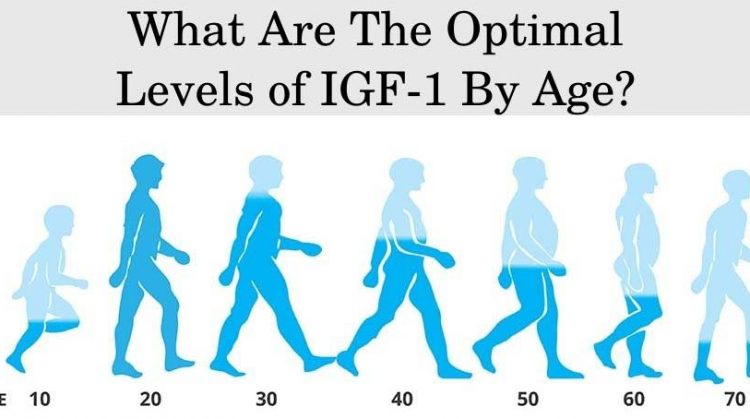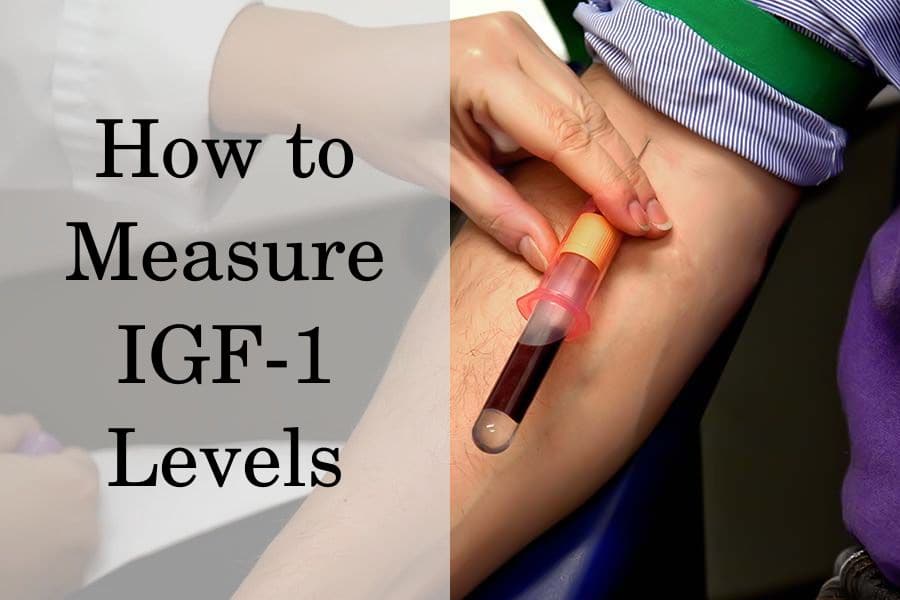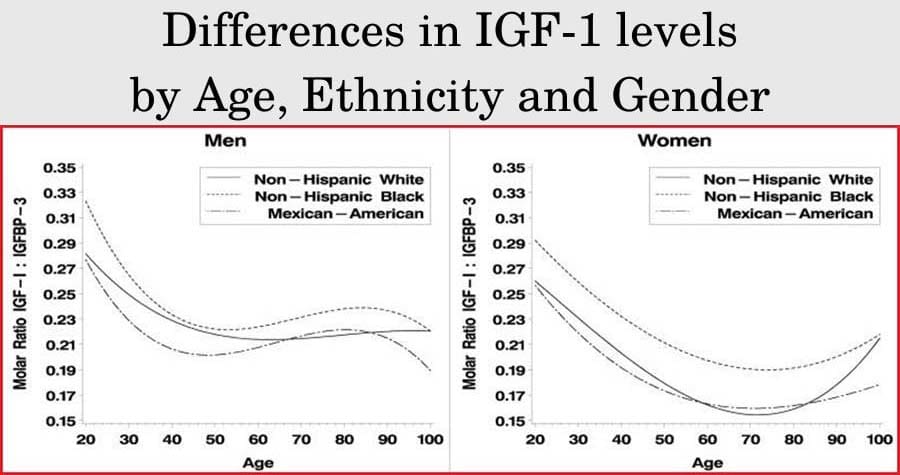
The insulin-like growth factor 1 (IGF-1) is the main mediator of the human growth hormone (hGH). More specifically, IGF-1 mediates its anabolic effects such as growth, development, and recovery in each of your tissues.
Together, the two hormones form the so-called GH/IGF-1 axis which plays a major role at every age.
It stimulates the growth of children as the levels of growth hormone IGF-1 slowly increase during childhood and reach a peak during puberty, coinciding with the pubertal growth spurt.
Then, IGF-1 slowly declines throughout adulthood, but your body continues to produce it under the stimulus of hGH as you need it for recovery, preserving bone mass, muscle mass, and tissue hypertrophy.
If your insulin-like growth factor 1 levels drop too low, it can lead to bone loss, slower recovery after injuries, muscle atrophy, and reduced performance.
On the other hand, an excess of IGF-1 can lead to acromegaly and shorter life expectancy. That’s why it is important to keep your IGF-1 balanced for optimal health and quality of life.
How to Test IGF-1
A blood sample is the only reliable way to test your IGF-1. Thus, you will have to visit a lab in person, where an experienced healthcare professional will draw a small amount of blood from the vein in your arm.
The whole process takes less than a few minutes as the professional will insert a small needle into your vein and collect the blood in a tube or a vial. You may feel a slight sting as the needle is inserted.
Make sure to warn the healthcare professional if you have a history of fainting during such procedures or if you have problems with your coagulation. Overall, there is very little risk in having a blood test – usually only mild bruising or pain that goes away quickly.
There is no need for any special preparation before the test, except for discontinuing any biotin supplements that you may be taking. Researchers warn that biotin supplementation may interfere with the standard immunoassays used for measuring various indicators including IGF-1.
In addition, there are also more accurate but much more expensive tests for measuring IGF-1 in serum sample collections which involve using mass spectrometry.
A doctor will most likely assign you an IGF-1 test in order to determine if they suspect that you may have growth hormone deficiency (GHD).
That’s because circulating IGF-1 levels correspond to the mean levels of growth hormone in the body. Yet, testing growth hormone levels directly is not quite informative because it can fluctuate a lot. On the other hand, IGF-1 levels are relatively stable throughout the day.
Keep in mind that the IGF-1 test has relatively low sensitivity and normal IGF-1 levels do not exclude GHD
Apart from GHD, an imbalance of your IGF-1 can be caused by growth hormone insensitivity (a congenital condition also known as Laron’s syndrome) or due to liver cirrhosis.
The liver is the main organ that releases IGF-1 in the blood under the stimulus of hGH, so if your liver is severely damaged, your IGF-1 will be low.
Normal IGF-1 Levels by Age and Gender
There is not universal cut-off point for normal IGF-1 levels in adults. Instead, there are different reference ranges for this hormone depending on the age.
Here are the normal IGF-1 levels by age and gender which are based on several studies in children, adolescents, and adults:
|
IGF-1 levels in girls/women (ng/mL) |
IGF-1 levels in boys/men (ng/mL) |
||||
|
Age |
Minimum |
Maximum |
Age |
Minimum |
Maximum |
|
0-1 |
40.8 |
152.8 |
0-1 |
58.1 |
143 |
|
2-3 |
93.4 |
176.1 |
2-3 |
70.3 |
149.1 |
|
4-5 |
115.7 |
210.3 |
4-5 |
73.2 |
154.9 |
|
6-7 |
160.5 |
257.2 |
6-7 |
138 |
234.9 |
|
8-10 |
186.5 |
543.4 |
8-10 |
152.9 |
424.5 |
|
Puberty (11-17) |
335.2 |
716.6 |
Puberty (11-17) |
359.4 |
850.1 |
|
18 |
286.1 |
486 |
18 |
292.4 |
458.4 |
|
19 |
238 |
424.5 |
19 |
232.6 |
397.6 |
|
20-24 |
200.6 |
370.6 |
20-24 |
189.8 |
343.7 |
|
25-29 |
171.4 |
324.6 |
25-29 |
159.5 |
298.7 |
|
30-34 |
148.6 |
286.3 |
30-34 |
138.4 |
263.3 |
|
35-39 |
130.8 |
255 |
35-39 |
124.2 |
236.7 |
|
40-44 |
116.7 |
229.6 |
40-44 |
114.9 |
217.6 |
|
45-49 |
105.2 |
209 |
45-49 |
108.6 |
203.9 |
|
50-54 |
95.1 |
191.5 |
50-54 |
103.8 |
193.6 |
|
55-59 |
85.6 |
175.5 |
55-59 |
98.8 |
184.7 |
|
60-64 |
75.7 |
159.3 |
60-64 |
92.2 |
174.9 |
|
65-69 |
64.5 |
140.9 |
65-69 |
82.5 |
161.8 |
|
≥70 |
51.5 |
118.2 |
≥70 |
68.7 |
142.7 |
As you can see from the table, sex does not affect IGF-1 levels significantly. IGF-1 levels peak during puberty and then slowly decline throughout adulthood in both genders.
These age-related changes are in accordance with the growth hormone levels in the body. The peak in GH/IGF-1 levels also coincides with the rapid growth and development during puberty
Having adequate GH and IGF-1 levels during childhood and adolescence allows individuals to reach their final height.
Genetics, diet, physical activity, body weight, and body composition can influence IGF-1 levels in adults
Although growth is complete after the end of puberty, optimal IGF-1 continues to support several anabolic processes in adults including muscle hypertrophy, tissue growth and regeneration, and bone mineral density.
Apart from age, several other factors may also influence the levels of IGF-1 in adults. These include genetics, diet, physical activity, body weight, and body composition.
For example, different populations may have different average IGF-1 levels. According to one study, Caucasian people and African-American people had slightly higher IGF-1 levels compared to Mexican-American individuals.
Furthermore, your body weight and body composition can influence the IGF-1 levels in your body quite significantly. Studies show that obese individuals have about 35% lower IGF-1 levels compared to adults with normal BMI. Besides, losing as much as 30 kg of body weight resulted in a 40% increase in the IGF-1 levels in the obese individuals in the study.
People who practice fasting or restrict their protein intake may also have lower IGF-1compared to the average individual. That’s because fasting and insufficient protein intake can lead to the release of a hormone called FGF21 which reduces the stimulus of hGH on IGF-1 synthesis.
Symptoms of Low IGF-1 Levels in Adults and Children
An IGF-1 imbalance can affect your life differently depending on your age. For example, low IGF-1 will have different effects on children compared to adults.
Children with IGF-1 deficiency experience stunted growth and short stature. Usually, the condition is due to growth hormone deficiency or growth hormone insensitivity.
Low IGF-1 levels in adults can lead to muscle wasting and atrophy, low bone mineral density, slower recovery from injuries, and an increased risk of bone fractures. If your condition is due to GHD, you may also experience reduced energy levels, body fat gain, and an increased risk of cardiovascular diseases.
Symptoms of High IGF-1 Levels in Adults and Children
If your IGF-1 levels are higher than the normal reference range for your age, this may indicate excessive production of hGH. An excess of pituitary hormones is almost always caused by a pituitary tumor such as an adenoma. The tumor size or adenoma growth rate does not necessarily correlate with the severity of IGF-1 excess.
In children, GH/IGF-1 excess is extremely rare and can lead to a condition called gigantism, which manifests with excessive growth and body height that is way above average. The patients are tall with long limbs and elongated torsos.
High IGF-1 levels in adults can lead to development of acromegaly. The condition does not affect the height of the patients, but symptoms of acromegaly can include increased bone and cartilage thickness.
Typical acromegaly symptoms include the enlargement of the hands and feet, distinctive facial changes, and joint discomfort.
Early acromegaly diagnosis is essential to prevent long-term complications, while Acromegaly treatment often involves a combination of medications, surgery, and sometimes conventional radiation therapy to manage hormone levels effectively.
Patients with GH/IGF-1 excess also tend to develop excessive sweating, high blood pressure, arthritis, elevated blood glucose levels, insulin resistance and have a shorter life expectancy.
What to Do With IGF-1 Imbalance?
The management of an IGF-1 imbalance depends on its main cause. If you have low IGF-1, then the most likely cause for your condition is GHD. In such cases, your doctor will assess your symptoms and assign you a provocation test such as an insulin tolerance test to confirm the diagnosis.
Adults with growth hormone deficiency can successfully manage all their symptoms by taking recombinant hGH injections daily.
If you have low IGF-1 due to Laron’s syndrome, then there will be no effects from growth hormone therapy.
Instead, an appropriate treatment should involve the use of recombinant IGF-1 and IGFBP3 – the protein that normally binds to the hormone. Similar to growth hormone therapy, the medication is administered via subcutaneous injections.
If you are already healthy, then the best options to increase IGF-1 levels naturally include maintaining a healthy body weight, avoiding fasting or protein restriction, and exercising regularly.
If you have abnormally high IGF-1, then your doctor will also assign you an growth hormone levels test and an magnetic resonance imaging (MRI) to look for a hormone-secreting pituitary tumor. The condition can be managed by treating the pituitary gland with surgery, radiation treatments, or medications.
Unfortunately, the therapy (especially if it involves a high dose of radiation) is often followed by the development of childhood or adult growth hormone deficiency and the patients may require growth hormone treatment to manage the symptoms in adults with growth hormone deficiency.



 Request Appointment
Request Appointment




